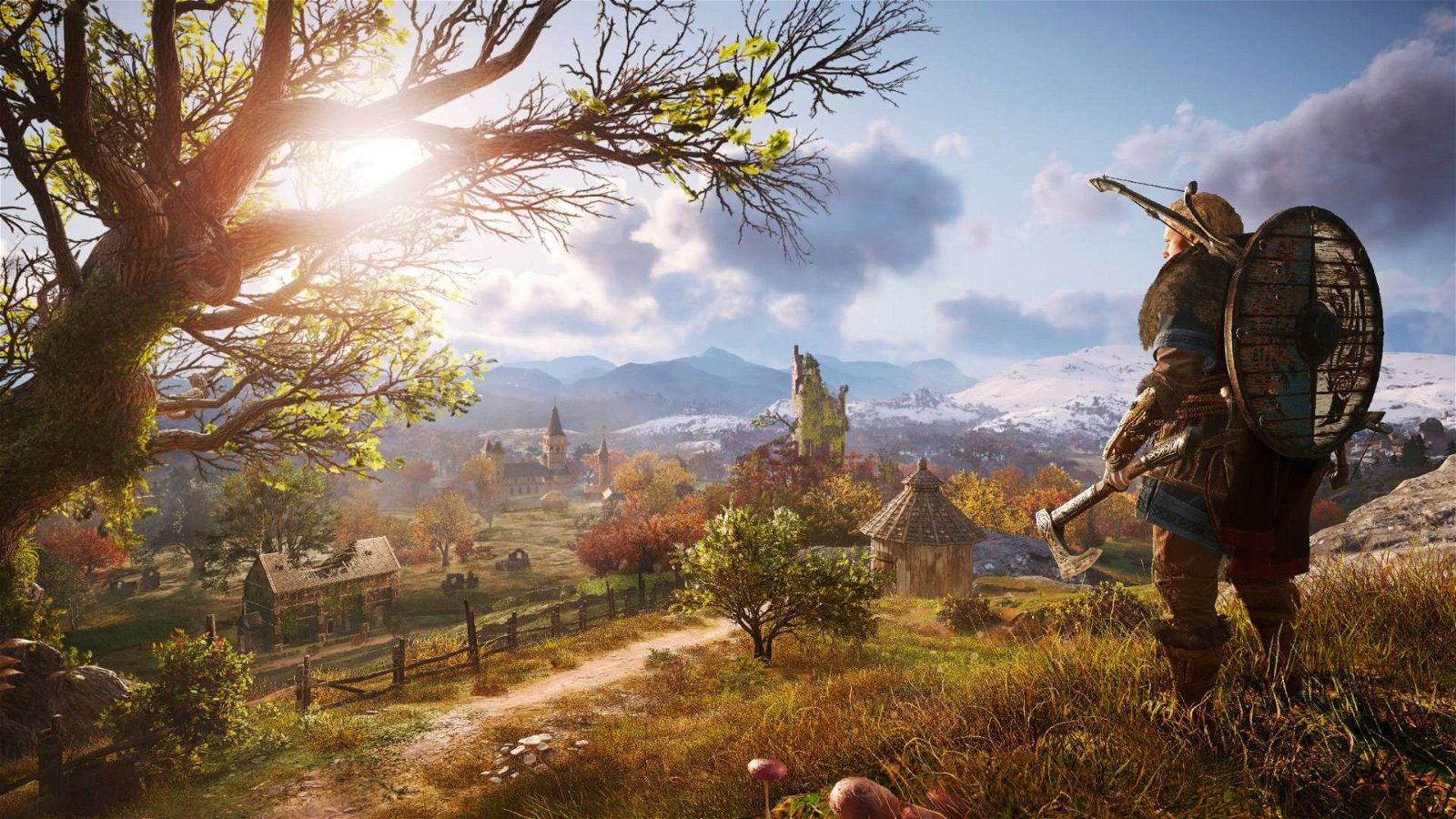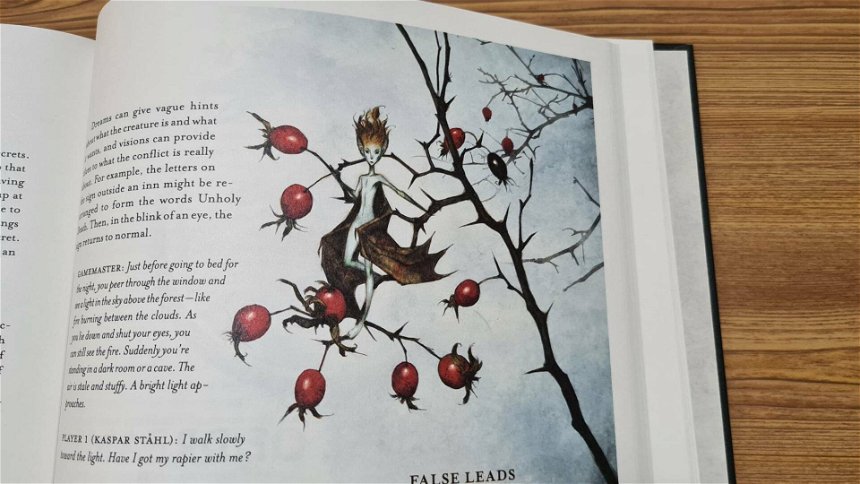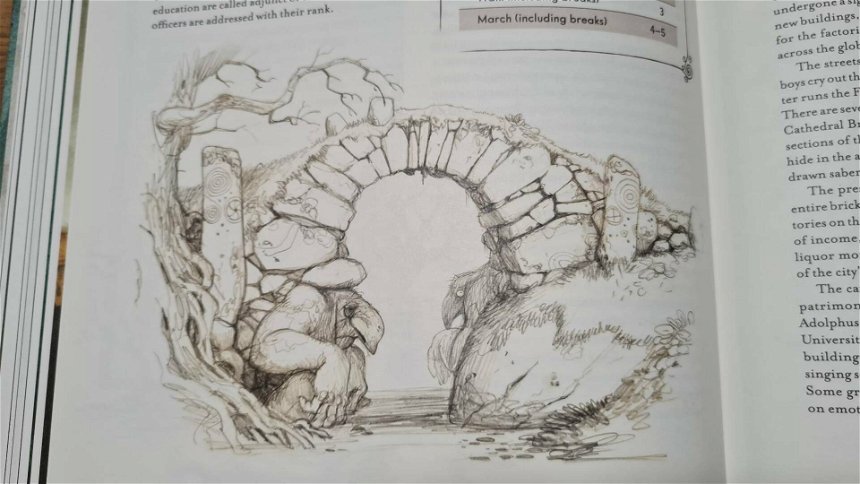Nei giorni scorsi, abbiamo avuto il privilegio di poter intervistare Nils Hintze, uno degli autori più importanti della casa editrice svedese Free League Publishing. Al suo attivo ci sono giochi di ruolo che hanno vinto premi su premi e che sono stati osannati da pubblico e critica, come Tales frome the Loop (di cui potete leggere la nostra recensione), Things frome the Flood (di cui potete leggere la nostra recensione) e l'ultimo nato: Vaesen – Nordic Horror Roleplaying, da noi recentemente recensito e oggetto di questa intervista.
Riferendoci al gioco di ruolo Vaesen, ricordiamo, inotre, che Johan Egerkrans, che sarà protagonista di una prossima intervista, è il principale creatore, artista e autore del libro acclamato dalla critica Vaesen: Spirits and Monsters of Scandinavian Folklore, su cui è basato il mondo di gioco.
Riportiamo, in fondo all’intervista, la stessa in lingua inglese.
L'intervista a Nils Hintze
Ciao Nils, grazie per il tempo che ci dedichi. Sappiamo che sei un autore pluripremiato che ha realizzato per Free League Publishing i giochi di ruolo di successo Tales from the Loop e Things from the Flood, e ora Vaesen – Nordic Horror Roleplaying, che siamo certi otterrà il medesimo successo. Raccontaci qualcosa in più di te: quando ti sei avvicinato al mondo del gioco di ruolo? Cosa ti ha spinto a diventare un game designer?
Ciao Davide, è un piacere! Ho iniziato a giocare ai giochi di ruolo prima di saper leggere correttamente. Durante la metà degli anni Ottanta, mio fratello maggiore Gustaf ricevette un gioco di ruolo come regalo di compleanno, nostra madre lo lesse e fu il nostro primo GM. Ricordo che interpretavo un nano e Gustaf era un elfo. La prima battuta del mio personaggio è stata: "Tira la tua freccia" e improvvisamente noi tre abbiamo capito come si gioca.
Per tutta la mia giovinezza ho scritto racconti, romanzi e in seguito opere teatrali per gruppi teatrali. Ma è stato molto più tardi che ho iniziato a scrivere scenari fan-made per un piccolo gioco di ruolo chiamato "Oktoberlandet" scritto da Christian Mehrstam (Whitehack e Suldokar's Wake). Ciò mi ha portato a scrivere per altri giochi e poi ho iniziato a scrivere per Free League.
Lavoro come psicologo per la Croce Rossa e penso che il mio interesse per le persone, i loro pensieri, emozioni e relazioni sia una parte centrale di come gioco e scrivo giochi di ruolo. Per me, l'interazione tra i personaggi è la parte più interessante dell'hobby.
Abbiamo appena pubblicato una recensione piuttosto esaustiva del bundle di Vaesen e abbiamo notato che il gioco sta suscitando un certo interesse nella community italiana, vogliamo quindi approfittare della presenza del suo autore per chiedere: cos’è Vaesen – Nordic Horror Roleplaying?
Chiunque abbia letto o ascoltato le vere storie dietro ai film Disney “La sirenetta”, “Frozen”, “Pinocchio” e “Biancaneve” coglierà l'atmosfera del gioco. Si tratta di un diverso tipo di mondo fantasy, che può essere davvero cupo e imperdonabile, ma in superficie non è un gioco completamente horror.
Nell’ambientazione del gioco, le persone vivono in un mondo dove ci sono "vaesen" invisibili (“vaesen” significa “creatura” in lingua danese, NdR.). A volte aiutano, a volte creano problemi. Purtroppo, il mondo sta cadendo a pezzi, come conseguenza dell'industrializzazione. Le persone lasciano le loro vecchie case e si trasferiscono nelle città per lavorare nelle fabbriche. Questo rompe il legame che esiste da secoli tra gli esseri umani e i vaesen. Alcuni vaesen scompaiono, mentre altri impazziscono e iniziano ad attaccare le persone. A volte sono i vaesen a essere vittime delle azioni umane.
I personaggi giocanti sono tutti dotati della Vista - il che significa che possono vedere i vaesen - e sono tutti membri di una società che cerca di proteggere le persone dai vaesen. Nel gioco, i personaggi dei giocatori lasciano la città per andare in campagna a risolvere i misteri. Il gioco funziona bene come campagna a episodi, in cui ogni scenario ha un nuovo "nemico" o problema.
Penso che sia un gioco facile da giocare e credo che sia perfetto per i principianti. I giocatori dovrebbero concentrarsi sul raccontare una bella storia insieme, piuttosto che "vincere" o cercare di creare il personaggio migliore e più cattivo. È un gioco di cooperazione e scoperta congiunta.
Generalmente, i giochi di ruolo a tema horror basano il loro immaginario orrorifico su temi ben noti e rodati, come i Miti di Cthulhu o la figura del vampiro, giusto per citarne un paio. Vaesen, invece, fa suo un immaginario decisamente diverso dal solito e per certi versi più radicato nella memoria, il folklore e nella fattispecie, quello nordico. Cosa ti ha spinto a orientarti verso questa ambientazione?
Per me, in quanto svedese, le antiche storie folcloristiche sono radicate nel mio passato e nei luoghi in cui ho vissuto. Posso immergermi nella storia di questi luoghi e nella storia dei miei antenati e trovare racconti con i vaesen che posso usare come misteri nel gioco. Immagino che questo capiti ovunque si viva, poiché ci sono storie di folclore in tutto il mondo. Crea una connessione tra la mia vita e il gioco che giochiamo.
Le storie sui vaesen, siano essi giapponesi, svedesi o italiani, la dicono lunga sull'essere umano. Il folklore nasce come un modo per cercare di capire la vita e renderla sopportabile. I racconti di vaesen che rubano bambini o fanno fare cose strane alle persone erano modi per parlare di bambini che muoiono e persone che impazziscono. Quando i troll danno a qualcuno una pentola d'oro, è un modo per aiutare le persone a provare speranza anche quando stanno morendo di fame.
Queste creature non sono state inventate solo per essere spaventose. Sono un mezzo per parlare delle cose orribili che accadono nella vita reale o dei sogni di un futuro migliore. Nelle società in cui sono stati creati avevano un significato. Per me, questo ha un certo "peso". Rende il gioco più significativo.
Vaesen – Nordic Horror Roleplaying è il terzo gioco di cui sei autore, dopo Tales from the Loop e Things from the Flood, che trae ispirazione dalle opere d’arte di un illustratore di altissimo livello, in questo caso Johan Egerkrans. Quanto peso hanno avuto le immagini nel processo di creazione dell’ambientazione?
Naturalmente, le illustrazioni di Johan hanno avuto molta influenza sul testo. Ho anche letto molti libri e testi sui vaesen e sul folklore.
Vaesen si appoggia al sistema di gioco Year Zero Engine, che è il fondamento di quasi tutti i giochi di ruolo di Free League Publishing, dimostrandosi un motore di gioco estremamente adattabile e malleabile. Secondo te qual è il suo maggiore punto di forza?
Penso che la sua forza sia che è facile e veloce, e penso che le regole per forzare un tiro aggiungano drammaticità ed eccitazione non solo alla finzione ma anche al tavolo. Non ho tempo per giocare a giochi complicati e in effetti non mi interessano. Voglio la storia, l'azione, il dramma e l'interazione e per questo lo Year Zero Engine funziona bene.
Quali sono state le maggiori sfide che hai dovuto affrontare nello sviluppo di Vaesen?
È stato difficile decidere quante informazioni avremmo dovuto fornire sui paesi nordici nel XIX secolo. Se ne avessimo date poche sarebbe diventato difficile visualizzarli, ma se ne avessimo fornite troppe, si sarebbe creata la sensazione che era il gioco a dettare come avrebbe dovuto essere il mondo, non i giocatori e il GM. Alla fine, abbiamo deciso di non avere a che fare con tanti fatti e di incoraggiare le persone a creare la propria versione di questo mondo.
Nel regolamento di Vaesen possiamo ritrovare elementi che hanno caratterizzato alcuni giochi di ruolo precedenti, come ad esempio la gestione dell’Headquarter che ricorda quella dello Stronghold in Forbidden Lands. È corretto dire che Vaesen prende tutto ciò che c’era di buono nei giochi precedenti e lo innalza a un livello successivo?
Sì, e penso che questo sia il modo in cui lavora Free League Publishing quando crea giochi. Ciò che è buono in un gioco viene preso in considerazione quando viene creato il gioco successivo. In questo modo, lo Year Zero Engine guadagna sempre più "parti" che possono essere collegate in modi diversi per creare un determinato gioco.
Le creature del mito e del folklore, nelle storie tradizionali, sono raramente viste come del tutto maligne e le opere d’arte di Johan Egerkrans presenti nel manuale sono davvero magnifiche, ma hanno più un aspetto fiabesco che terrificante. Quanto pensi possa essere complesso per un Game Master riuscire a conciliare l’aspetto fiabesco delle creature con l’atmosfera d’orrore su cui il gioco vuole puntare?
Penso che ogni GM dovrebbe trovare il proprio livello di orrore. Ma non bisogna dimenticare che le vecchie fiabe erano spesso oscure e raramente finivano bene. Alcune sono davvero terrificanti. Ad esempio, il finale de La Sirenetta, in cui ogni passo che fa per il resto della sua vita le procura un immenso dolore, o La piccola fiammiferaia, che muore congelata nella neve. La Disney ci ha fatto dimenticare come dovrebbero essere raccontate le storie. Ma se lo facciamo bene, le fiabe saranno piene di orrore.
In Vaesen si avverte fortemente una sorta di dicotomia tra creature del tutto malvage e altre che potremmo perfino definire “buone”. Ciò consente a un buon Game Master di creare misteri in cui nulla è bianco o nero, ma tutto si riempie di sfumature di grigio…
Sì, questo è qualcosa che troverai in tutto ciò che scrivo. Non mi interessa la divisione netta tra Bene e Male, perché non credo che esista. È una sorta di semplificazione della vita reale che rende ogni racconto poco interessante.
Pur avendo qualche similitudine con il folkore italiano, i miti di Vaesen sono piuttosto distanti da quelli dell'area del Mediterraneo, quali letture e quali film consiglieresti al nostro pubblico, per entrare maggiormente nell'atmosfera dell'ambientazione?
Consiglierei di ambientare il gioco in Italia e di utilizzare il folklore italiano.
Durante la campagna di crowdfunding di Vaesen, che è stato un vero successo, i sostenitori del progetto hanno potuto mettere le mani anche su un manuale di avventure: “A Grim Secret & Other Mysteries”. È prevista la pubblicazione di questo libro, in futuro?
Sì, e molto presto! :) Arriveranno altri misteri, poiché sembra che molti abbiano già giocato a quelli che abbiamo scritto finora.
Puoi rivelarci qualche indiscrezione sui prodotti di prossima pubblicazione riguardanti Vaesen – Nordic Horror Roleplaying? Riusciremo ad andare più a fondo sulla storia della Society e sui misteri che la circondano?
Come ho detto, ci saranno altri misteri. C'è anche un piano per una campagna che approfondirà i retroscena della Society e il collegamento tra i vaesen e gli umani. Ma altri prodotti verranno prima della campagna.
Parliamo più in generale del settore dei giochi di ruolo. Data la tua esperienza nello sviluppo di giochi di ruolo, come è cambiato l’approccio al game design dei giochi nel corso degli ultimi decenni?
Per come la vedo io, il movimento Story Now con giochi come Sorcerer, The Shadow of Yesterday e My Life with Master si è fuso con il modo "tradizionale" di scrivere e giocare, creando giochi che hanno sia scenari scritti sia regole leggere, che si concentrano sull'interazione tra personaggi, e strumenti per creare storie interessanti.
Penso che anche il movimento OSR (Old School Renaissance) stia per essere incorporato, con il suo modo di scrivere campagne, fare affidamento su tabelle e probabilità per decidere cosa incontrano i personaggi, e la mortalità di quei giochi.
Penso anche che lo standard di come il gioco viene presentato, con illustrazioni e grafica, si sia innalzato molto, in realtà soprattutto grazie ai game designer svedesi.
Quello che stiamo vivendo è un’era molto interessante nella storia del gioco di ruolo, come vedi questo grande rinascimento? Esiste il rischio che il mercato collassi su se stesso, dato l’elevato numero di giochi che vengono costantemente pubblicati?
Viviamo in un'epoca in cui è normale che gli adulti giochino e siano affascinati da draghi e dinosauri, a differenza dell’epoca in cui sono cresciuto, quando solo i bambini facevano queste cose. Ora, esiste un mercato gigantesco per giochi di qualsiasi tipo e non credo che la situazione cambierà presto. Sono più stupito che ci siano così poche persone che giocano ai giochi di ruolo, quando ce ne sono così tante che amano gli spettacoli televisivi su HBO e Netflix. I giochi di ruolo sono un modo molto migliore di vivere lo stesso tipo di storie. Chiunque riuscirà a far giocare i normali fan della HBO, diventerà miliardario.
Cosa vuoi dire ai giocatori italiani per convincerli a provare Vaesen?
È facile, divertente e si tratta di raccontare una storia insieme.
Grazie ancora Nils per il tuo tempo e la tua cordialità
Grazie per avermi ospitato!
The interview with Nils Hintze in English
Hi Nils, thank you for your time. We know you are an award-winning author who made the hit RPGs Tales from the Loop and Things from the Flood for Free League Publishing, and now Vaesen - Nordic Horror Roleplaying, which we are confident will achieve the same success. Tell us a little more about yourself: when did you approach the world of roleplaying games? What prompted you to become a game designer?
Hi Davide, it's a pleasure! I started to play RPGs before I could read properly. During the middle of the eighties, my older brother Gustaf got an RPG as a birthday present, and our mother read it and was our first GM. I remember that I played a dwarf and Gustaf was an elf. My first in-character line was “Shoot it with your arrow”, and suddenly the three of us understood how to play the game.
All through my childhood, I wrote short stories, novel, and later on plays for theater groups. But it was much later that I started to write fan-made scenarios for a small RPG called “Oktoberlandet” written by Christian Mehrstam (Whitehack and Suldokar’s Wake). That led me into writing for other games and then I started to write for the Free League.
I work as psychologist for the Red Cross, and I think my interest in people, and their thoughts, emotions, and relationships is a central part of how I play and write RPGs. To me, the interaction between characters is the most interesting part of the hobby.
We have just published a rather comprehensive review of the Vaesen bundle and we have noticed that the game is arousing some interest in the Italian community, so we want to take advantage of the presence of its author to ask: what is Vaesen - Nordic Horror Roleplaying?
Anyone who has read or heard the real stories behind the Disney movies The Little Mermaid, Frozen, Pinocchio and Snow White will grasp the mood of the game. This is a different kind of fantasy-world, that can be really grim and unforgiven, but on the surface it is not an all out horror game.
People in this world live in a world where there are invisible “vaesen”. Sometimes, they help, and sometimes they make trouble. Unfortunately, the world is falling apart, as a consequence of the industrialization. People are leaving their old homes and moving to the cities to work at the factories. This breaks the bond that has existed for ages between humans and vaesen. Some vaesen disappear, while other go mad and start attacking people. Sometimes it is the vaesen who are the victims of human actions.
The player characters are all gifted with the sight—which means that they can see vaesen—and they are all members of a society that tries to protect people from vaesen. In the game, the player characters leave the city to go out in the countryside to solve mysteries. The game works well as an episodic campaign, where every scenario has a new “enemy” or problem.
I think it is an easy game to play, and I believe it works well for beginners. The players should be focused on telling a good story together, rather than “winning” or trying to create the best and badest player character. It is a game of cooperation and joint discovery.
Generally, horror-themed RPGs base their horror imagery on well-known and well-established themes, such as the Cthulhu Mythos or the figure of the vampire, just to name a couple. Vaesen, on the other hand, adopts an imaginary decidedly different from the usual one and in some ways more rooted in memory, folklore and in this case the Nordic one. What prompted you to move yourself towards this setting?
To me, as a Swede, the old folklore stories are rooted in my background and in the places where I have lived. I can look into the history of these places and the history of my ancestors and find stories featuring vaesen that I can use as mysteries in the game. I guess this is true wherever one lives, as there are folklore stories all over the world. It creates a connection between my own life and the game we play.
Stories about vaesen, whether they are from Japan, Sweden, or Italy, says a lot about being human. The folklore was created as a way to try to understand life and make it bearable. Tales about vaesen stealing children or making people do strange things were ways of talking about children dying and people going mad. When the trolls give someone a pot of gold, it is a way to help people feel hope even when they are starving.
These creatures were not only invented to be frightful. They are used to speak about horrible things that happen in real life, or about dreams of a better future. In the societies where they were created, they had meaning. To me, that has a kind “weight” to it. It makes the game become more meaningful.
Vaesen - Nordic Horror Roleplaying is the third game of which you are author, after Tales from the Loop and Things from the Flood, which draws inspiration from the works of art of a very talented illustrator, in this case Johan Egerkrans. How much weight did the images have in the setting creation process?
Of course, Johan’s illustration had a lot of influence on the text. I also read a lot of books and texts about vaesen and folklore.
Vaesen relies on the Year Zero Engine game system, which is the base of nearly all Free League Publishing RPGs, proving to be an extremely adaptable and malleable game engine. In your opinion what is its greatest strength?
I think its strength is that is easy and quick, and I think the rules for pushing a roll adds drama and excitement not only to the fiction but also to the table. I don’t have time to play complicated games, and in fact, they do not interest me. I want story, and action, and drama and interaction—and for that, the Year Zero engine works well.
What were the biggest challenges you faced in developing Vaesen?
It was hard to decide how much information we should give about the Nordic countries in the 19th century. If we gave to little it becomes hard to visualize it, but if we give too much, it creates a feeling that the game dictates how the world should be, not the players and the GM. In the end we decided to not have that much facts and encourage people to create their own version of this world.
In the Vaesen rulebook we can find elements that have characterized some previous role-playing games, such as the Headquarter management the that recalls the Stronghold management in Forbidden Lands. Is it fair to say that Vaesen takes everything good from previous games and takes it to the next level?
Yes, and I think this is the way Free League Publishing works when they create games. What is good in one game, is considered when the next game is being created. In that way, the Year Zero Engine gets more and more “parts” that can be connected in different ways to create a certain game.
The creatures of myth and folklore in traditional stories are rarely seen as completely evil, and the works of art by Johan Egerkrans featured in the manual are truly magnificent, but they have more a fairy-tale look than a terrifying one. How complex do you think it can be for a Game Master to be able to reconcile the fairytale aspect of creatures with the horror atmosphere that the game wants to focus on?
I think every GM should find his or her own level of horror. But one should not forget that the old fairy tales were often dark and seldom ended well. Some of them are truly horrifying, for example the ending of the Little Mermaid where she has to walk with immense pain every step she takes for the rest of her life, or The Little Match Girl who freezes to death in the snow. Disney has made us forget how the tales should be told. But if we do it right, the fairytales will be filled with horror.
In Vaesen there is a strong kind of dichotomy between completely evil creatures and others that we could even define "good". This allows a good Game Master to create mysteries where nothing is black or white, but everything is filled with shades of gray…
Yes, this is something that you will find in everything I write. I am not interested in the all Good or all Evil, as I do not think it exists. It is a kind of simplification of real life that makes any tale uninteresting.
Although having some similarities with Italian folkore, the myths of Vaesen are quite distant from those of the Mediterranean area, which readings and which films would you recommend to our audience, to get more into the atmosphere of the setting?
I would recommend placing the game in Italy and using the Italian folklore.
During Vaesen's crowdfunding campaign, which was a real success, bakers of the project were also able to get their hands on an adventure manual: “A Grim Secret & Other Mysteries”. Are there any plans for this book to be published in the future?
Yes, and very soon! :) More mysteries will come, as it seems that many have already played the ones we have written so far.
Can you tell us any indiscretions about upcoming products regarding Vaesen - Nordic Horror Roleplaying? Will we be able to delve deeper into the history of the Society and the mysteries surrounding it?
As I said, there will be more mysteries. There is also a plan for a campaign that will dig deeper into the background of the Society and the connection between vaesen and humans. But other products will come before the campaign.
Let's talk more generally about the RPG industry. Given your experience in RPG development, how has the approach to game design changed over the past few decades?
As I see it, the Story Now movement with games like Sorcerer, The Shadow of Yesterday and My Life with Master has merged with the “traditional” way of writing and playing games, creating games that has both written scenarios and light-weight rules that focus on interaction between characters and tools for creating interesting stories.
I think the osr-movement (old school renaissance) is about to be incorporated as well, with its way of writing campaigns, relying on tables and chance to decide what the characters encounter, and the deadliness of those games.
I also think that the standard of how the game is presented with illustrations and graphic design has been raised a lot, actually most thanks to Swedish game designers.
What we are experiencing is a very interesting era in the history of role-playing game, how do you see this great renaissance? Is there a risk that the market collapses on itself, given the high number of games that are constantly being released?
We live in a time where it is ok for adults to play games and be fascinated by dragons and dinosaurs, in difference to the time when I grew up, when only kids did these things. Now, there is a gigantic market for games of any kind, and I can’t see that changing anytime soon. I am more amazed that there are so few people playing RPGs when there are so many who love the tv-shows on HBO and Netflix. RPGs is a much better way of experiencing the same kind of stories. Anyone who can make the regular HBO-fan play games instead will become a billionaire.
What do you want to say to the Italian players to convince them to try Vaesen?
It is easy, it is fun, and it is about telling a story together.
Thanks again Nils for your time and your friendliness.
Thanks for having me!










